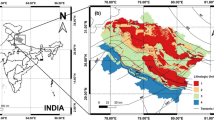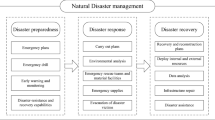Abstract
Natural hazards such as earthquakes threaten millions of people all around the world. In a few decades, most of these people will live in fast-growing, inter-connected urban environments. Assessing risk will, therefore, be an increasingly difficult task that will require new, multidisciplinary approaches to be tackled properly. We propose a novel approach based on different imaging technologies and a Bayesian information integration scheme to characterize exposure and vulnerability models, which are among the key components of seismic risk assessment.
























Similar content being viewed by others
References
Aytekin O, Ulusoy I, Erener A, Duzgun HSB (2009) Automatic and unsupervised building extraction in complex urban environments from multi spectral satellite imagery. In: Recent advances in space technologies, 2009. RAST’09. 4th international conference on, pp 287–291
Bayraktarli YY, Faber MH (2011) Bayesian probabilistic network approach for managing earthquake risks of cities. Georisk Assess Manag Risk Eng Syst Geohazards 5:2–24
Bindi D, Mayfield M, Parolai S, Tyagunov S, Begaliev U, Abdrakhmatov K, Moldobekov B, Zschau J (2011) Towards an improved seismic risk scenario for bishkek, kyrgyz republic. Soil Dyn Earthq Eng 31:521–525
Calvi GM, Pinho R, Magenes G, Bommer JJ, Restrepo-Velez LF, Crowley H (2006) Development of seismic vulnerability assessment methodologies over the past 30 years. ISET J Earthq Technol 43(472):75–104
Coburn AW, Spence R, Pomonis A (1994) Vulnerability and risk assessment. UNDP Disaster Management Training Programme
Cochran W (1977) Sampling techniques, 3rd edn. Wiley, New York
Cox DR, Isham V (1980) Point processes. Chapman and Hall, London
Durieux L, Lagabrielle E, Nelson A (2008) A method for monitoring building construction in urban sprawl areas using object-based analysis of spot 5 images and existing GIS data. ISPRS J Photogramm Remote Sens 63(4):399–408
Ehrlich D, Zeug G, Gallego J, Gerhardinger A, Caravaggi I, Pesaresi M (2010) Quantifying the building stock from optical high-resolution satellite imagery for assessing disaster risk. Geocarto Int 25:281–293
Erdik M, Rashidov T, Safak E, Turdukulov A (2005) Assessment of seismic risk in tashkent, uzbekistan and bishkek, kyrgyz republic. Soil Dyn Earthq Eng 25:473–486
Felzenszwalb PF, Huttenlocher DP (2004) Efficient graph-based image segmentation. Int J Comput Vis 59(2):167–181
Gelfand AE, Smith AFM (1990) Sampling-based approaches to calculating marginal densities. J Am Stat Assoc 85:398–409
Grossi P, Kleindorfer PR, Kunreuther H (1999) The impact of uncertainty in managing seismic risk: the case of earthquake frequency and structural vulnerability. Wharton Financial Institution Center WP 99-03-26, Risk Management and Decision Processes Center, The Wharton School, Philadelphia, PA
Grunthal G, Commission ES (1998) European macroseismic scale 1998 : EMS-98. Luxembourg: European seismological commission subcommission on engineering seismology working group macroseismic scales, 2nd edn
Haggrén H, Hyyppä H, Jokinena O, Kukko A, Nuikka M, Pitkänen T, Pöntinen P, Rönnholma P (2004) Photogrammetric application of spherical imaging. In: Panoramic photogrammetry workshop, Dresden, 19/22 February
Heckerman D, Geiger D, Chickering D (1995) Learning bayesian networks: the combination of knowledge and statistical data. Mach learn 20(3):197–243
Li L, Wang J, Leung H (2010) Using spatial analysis and bayesian network to model the vulnerability and make insurance pricing of catastrophic risk. Int J Geogr Inf Sci 24:1759–1784
Michael AJ (2011) Random variability explains apparent global clustering of large earthquakes. Geophys Res Lett 38:L21301. doi:10.1029/2011GL049443
Pearl J (1985) bayesian networks: a model of self-activated memory for evidential reasoning. In: Proceedings of seventh annual conference of the cognitive science society
Pearl J (1991) Probabilistic reasoning in intelligent systems: networks of plausible inference. Morgan Kaufmann Publishers, San Mateo
Ramm F, Topf J, Chilton S (2011) OpenstreetMap: using and enhancing the free map of the world. UIT Cambridge, Cambridge
Rapoport A (1980) Neighborhood heterogeneity or homogeneity: the field of man-environment studies. Archit Behav 1(1):65–77
Shi J, Malik J (2000) Normalized cuts and image segmentation. IEEE Trans Pattern Anal Mach Intell 22(8):888–905
Steimen S, Fh D, Giardini D, Bertogg M, Tschudi S (2004) Reliability of building inventories in seismic prone regions. Bull Earthq Eng 2(3):361–388
Steiniger S, Lange T, Burghardt D, Weibel R (2008) An approach for the classification of urban building structures based on discriminant analysis techniques. Trans GIS 12:31–59
Tao CV, Li J (2007) Advances in mobile mapping technology. Taylor & Francis, London
Teller S (1998) Toward urban model acquisition from geo-located images. In: Proceedings of pacific graphics, Singapore pp 45–51
Tobler WR (1970) A computer movie simulating urban growth in the detroit region. Econ Geogr 46(2):234–240
Torii A, Imiya A, Ohnishi N (2005) Two-and three-view geometry for spherical cameras. In: Proceedings of the sixth workshop on omnidirectional vision, camera networks and non-classical cameras
Vapnik V (2000) The nature of statistical learning theory, 2nd edn. Springer, New York
Wieland M, Pittore M, Parolai S, Zschau J (2012) Exposure estimation from Multi-Resolution optical satellite imagery for seismic risk assessment. ISPRS Int J Geo-Inf 1:69–88
Wieland M, Pittore M, Parolai S, Zschau J, Moldobekov B, Begaliev U (2012) Estimating building inventory for rapid seismic vulnerability assessment: towards an integrated approach based on multi-source imaging. Soil Dyn Earthq Eng
Acknowledgements
The authors wish to thank the unknown reviewers whose constructive comments and suggestions considerably improved the manuscript. The authors are also grateful to Dr. Kevin Fleming for stimulating many inspiring discussions. Particular thanks to CAIAG (Central Asian Institute for Applied Geoscience, Bishkek) and IntUIT (International University for Innovation Technologies, Bishkek) for their support during the ground-based data-capturing. This work was supported by PROGRESS (Georisiken im Globalen Wandel), Helmholtz-EOS (Earth Observation System) and CEDIM (Center for Disaster Management and Risk Reduction).
Author information
Authors and Affiliations
Corresponding author
Rights and permissions
About this article
Cite this article
Pittore, M., Wieland, M. Toward a rapid probabilistic seismic vulnerability assessment using satellite and ground-based remote sensing. Nat Hazards 68, 115–145 (2013). https://doi.org/10.1007/s11069-012-0475-z
Received:
Accepted:
Published:
Issue Date:
DOI: https://doi.org/10.1007/s11069-012-0475-z




